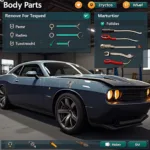A cracked bumper can be an eyesore, and unfortunately, it’s a common occurrence for car owners. Whether it’s from a minor fender bender, bumping a parking curb, or simply the wear and tear of driving, a damaged bumper can affect the aesthetics and potentially the safety of your vehicle. But before you rush to the auto shop, you might be able to tackle this repair yourself. This comprehensive guide will walk you through how to repair a cracked car bumper, helping you restore your car’s appearance and save some money in the process.
Assessing the Damage: Is a DIY Repair Possible?
Before you gather your tools, it’s crucial to assess the severity of the damage to your bumper. While minor cracks and scratches can often be repaired at home, larger dents and punctures might require professional intervention. Here’s a closer look at what you can typically handle yourself:
- Hairline Cracks and Scratches: These are superficial and primarily affect the paint. They are usually straightforward to repair with some sanding, filler, and paint.
- Small to Medium Cracks: Cracks that are a few inches long and not too wide can often be repaired with epoxy or plastic welding techniques.
- Cracks with Minimal Displacement: If the bumper sections haven’t significantly shifted out of place, a DIY repair is more likely to be successful.
Gathering Your Car Bumper Repair Arsenal
Having the right tools and materials is essential for a successful bumper repair. Here’s a checklist:
- Cleaning Supplies: Soap and water, degreaser, microfiber cloths
- Sandpaper: 80-grit, 180-grit, 320-grit
- Body Filler (Bondo): For filling in cracks and dents
- Putty Knife: For applying and smoothing body filler
- Epoxy or Plastic Welding Kit: Choose the appropriate one for your bumper material
- Masking Tape and Plastic Sheeting: For protecting surrounding areas
- Primer, Paint, and Clear Coat: Matched to your car’s color
- Safety Gear: Gloves, safety glasses, and a respirator
How to Repair a Cracked Car Bumper: A Step-by-Step Guide
Follow these steps to repair a cracked bumper on your car:
- Clean the Area: Thoroughly wash the damaged area with soap and water to remove dirt and grime. Use a degreaser to clean the surface where you’ll be applying any filler or adhesive.
- Sand Down the Crack: Use 80-grit sandpaper to sand down the area around the crack, creating a rough surface for better adhesion.
- Apply Body Filler: If the crack is significant, use a putty knife to apply body filler, overfilling slightly. Let it dry completely.
- Sand and Shape: Once dry, sand the filler smooth with 180-grit, then 320-grit sandpaper to match the bumper’s contour.
- Apply Epoxy or Plastic Weld: For deep cracks, follow the instructions on your chosen product. Epoxy is generally easier for beginners.
- Mask Off the Area: Use masking tape and plastic sheeting to protect the surrounding areas from paint overspray.
- Prime the Repaired Area: Apply several thin coats of primer, allowing each coat to dry before applying the next.
- Paint and Clear Coat: Apply thin coats of automotive paint matched to your car’s color. Finish with a clear coat for protection and shine.
Tips for a Professional-Looking Finish
- Patience is Key: Don’t rush the process. Allow ample drying time for filler, primer, and paint.
- Work in a Well-Ventilated Area: Fumes from chemicals and paint can be harmful.
- Consider a Professional for Major Damage: If the damage is extensive, it’s best to consult a professional for car bumper repairs.
Frequently Asked Questions About Cracked Bumper Repair
Can I use super glue to fix a cracked bumper?
Superglue might seem like a quick fix, but it’s not recommended for car bumper repairs. It doesn’t have the flexibility or durability to withstand the vibrations and stresses a bumper endures.
How much does it cost to repair a cracked bumper professionally?
The cost varies widely depending on the severity of the damage, your car’s make and model, and the shop’s labor rates. It’s always a good idea to get multiple quotes.
Can a cracked bumper affect my car’s safety?
In some cases, yes. A severely damaged bumper might not provide adequate protection in a collision. Additionally, if the bumper is cracked near lights or sensors, it could affect their functionality.
How can I prevent my car bumper from cracking?
Be mindful of parking curbs, avoid tight parking spaces, and drive defensively to minimize the chances of minor collisions.
Can I drive my car with a cracked bumper?
While it’s generally safe to drive with a minor crack, it’s best to get it repaired as soon as possible to prevent further damage and ensure your safety.
Need Expert Help with Your Car Repair?
We understand that tackling car repairs can be daunting, and not all cracks are created equal. If you’re unsure about tackling the repair yourself, or if the damage seems too extensive, CarRepairOnline is here to help. We have a network of trusted mechanics and auto body specialists who can provide expert car bumper repairs. Contact us today for assistance or to explore our other valuable resources for all your car repair needs.
Get in Touch!
WhatsApp: +1(641)206-8880
Email: [email protected]
Our customer support team is available 24/7 to assist you.



